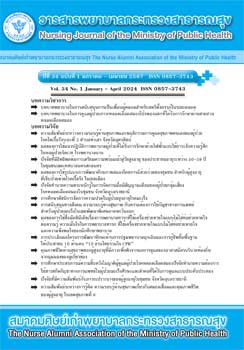ปัจจัยทำนายความต้องการใช้สารสกัดกัญชาทางการแพทย์ในผู้ป่วยมะเร็งศีรษะและลำคอ ที่ได้รับการดูแลแบบประคับประคอง
Main Article Content
บทคัดย่อ
สารสกัดกัญชาได้รับการนำมาใช้กับผู้ป่วยระยะประคับประคองเพื่อช่วยเพิ่มคุณภาพชีวิต โดยไม่พบผลข้างเคียงจากการใช้ยาที่รุนแรง แต่อย่างไรก็ตาม การใช้สารสกัดกัญชาอาจยังไม่ได้รับการยอมรับจากประชาชนอย่างกว้างขวาง การวิจัยครั้งนี้มีวัตถุประสงค์เพื่อศึกษาถึงความต้องการใช้สารสกัดกัญชาทางการแพทย์และปัจจัยทำนายความต้องการใช้สารสกัดกัญชาทางการแพทย์ในผู้ป่วยมะเร็งศีรษะและลำคอที่ได้รับการดูแลแบบประคับประคองในโรงพยาบาลมะเร็งชลบุรี กลุ่มตัวอย่างเป็นผู้ป่วยมะเร็งศีรษะและลำคอ ที่ได้รับการดูแลแบบประคับประคอง จำนวน 87 คน โดยวิธีการสุ่มอย่างง่าย เก็บรวบรวมข้อมูลระหว่างเดือนมกราคม ถึง เดือนพฤษภาคม พ.ศ. 2565 เครื่องมือที่ใช้ในการวิจัยประกอบด้วยแบบสอบถามสำหรับเก็บรวบรวมข้อมูล 5 ส่วน ได้แก่ 1) ข้อมูลส่วนบุคคล 2) การรับรู้ประโยชน์ของการใช้สารสกัดกัญชาทางการแพทย์ 3) การรับรู้อุปสรรคของการใช้สารสกัดกัญชาทางการแพทย์ 4) การสนับสนุนทางสังคมต่อการใช้สารสกัดกัญชาทางการแพทย์ และ 5) ความต้องการใช้สารสกัดกัญชาทางการแพทย์ ค่าความเชื่อมั่นของเครื่องมือส่วนที่ 2-5 เท่ากับ .78, .78, .82, และ .76 ตามลำดับ วิเคราะห์ข้อมูลโดยใช้สถิติเชิงพรรณนา และการวิเคราะห์ถดถอยพหุคูณแบบขั้นตอน (Stepwise multiple regression analysis) ผลการวิจัยพบว่า กลุ่มตัวอย่างมีความต้องการใช้สารสกัดกัญชาทางการแพทย์ อยู่ในระดับปานกลาง โดยการรับรู้ประโยชน์ของการใช้สารสกัดกัญชาทางการแพทย์ และการสนับสนุนทางสังคมต่อการใช้สารสกัดกัญชาทางการแพทย์ สามารถร่วมทำนายความต้องการใช้สารสกัดกัญชาทางการแพทย์ได้อย่างมีนัยสำคัญทางสถิติ (R2adj.=.41, p<.001) ผลการวิจัยครั้งนี้ บ่งชี้ว่าควรมีการเผยแพร่ข้อมูลความรู้เกี่ยวกับประโยชน์ของการใช้สารสกัดกัญชาทางการแพทย์ให้กับสังคมและผู้ป่วยที่ได้รับการดูแลแบบประคับประคอง โดยบุคลากรทางด้านสุขภาพอาจเผยแพร่องค์ความรู้ใหม่เกี่ยวกับการใช้สารสกัดกัญชาทางการแพทย์ที่ถูกต้องเหมาะสม เพื่อเพิ่มทางเลือกให้กับผู้ป่วยที่ได้รับการดูแลแบบประคับประคองในการมีคุณภาพชีวิตที่ดีในช่วงวาระสุดท้ายของชีวิต
Article Details

This work is licensed under a Creative Commons Attribution-NonCommercial-NoDerivatives 4.0 International License.
บทความและรายงานวิจัยในวารสารพยาบาลกระทรวงสาธารณสุข เป็นความคิดเห็นของ ผู้เขียน มิใช่ของคณะผู้จัดทำ และมิใช่ความรับผิดชอบของสมาคมศิษย์เก่าพยาบาลกระทรวงสาธารณสุข ซึ่งสามารถนำไปอ้างอิงได้
References
Department of Medical Services, Ministry of Public Health. Advice on medical cannabis use 2019. (cited 20 April 2023) Available from:https://mdresearch.kku.ac.th/files/cannabis/ Final%20 Guidance%20on%20Cannabis.pdf
World Health Organization. World cancer report 2020. (ePUB) World Health Organization Press; Lyon, France; 2020.
Public Health Statistics A.D.2020(Internet).(cited 20 April 2023). Available from: http:// dmsic.moph.go.th/index/detail/8900
Digital Medical Division, Chonburi Cancer Hospital. Hospital -base cancer registry 2020.
Chaikham R, Raksanaves L, Pichaya N, Sooksrisawat C. Factors predicting nutritional behaviors among patients with head and neck cancer at ChonBuri Cancer Hospital. Journal of The Department of Medical Services 2018; 43(6):68-73.(in Thai)
Kantha K, Kadmek S, Jaiban N. The result of developing palliative care and medical cannabis clinic in Chun Hospital Phayao Province. Journal of Disease Prevention and Control: DPC.2 Phitsanulok 2021; 8(3):41-56.
Pleumjai T, Management model for nursing service quality developing of palliative care in Songkhla Hospital. Journal of Prachomklao College of Nursing 2020; 3(1):73-94.
Yodying T, Namvongprom A, Pakdevong N. Educative-supportive care is needed in patients with advanced cancer undergoing chemotherapy. Journal of Nursing Science & Health 2019; 42(4):10-19.
Knewsee N, Satjapol C, Wilaipong P, Tumviriyakul H. Factor associated with cannabis use behavior of Cancer patient in outpatient department Phatthalung hospital. PCFM [Internet].2021 Dec.30 [cited 2023Apr.20];4(3):92-106.Available from: https://so03.tcithaijo.org/index.php/PCFM/article/ view/250108
Phanwichian K, Yoga R. Factors associated with cannabis usage on behavioral level for medical benefits of the people. The Journal of Boromarjonani College of Nursing Suphanburi 2020; 3(1):31-42.
Chaisaeng S. Development of a counseling clinic model for medical cannabis extract use at Ban Non Du Tambon Health Promoting Hospital, Mueang District, Amnat Charoen Province. Regional Health Promotion Center 9 Journal 2022; 16(1):45-58.
Martell K, Fairchild A, LeGerrier B, Sinha R, Baker S, Liu H, et al. Rates of cannabis use in patients with cancer. Curr Oncol 2018; 25(3): 219-25.
Abrams DL. Integrating cannabis into clinical cancer care. Curr Oncol 2016; 23(2): S8-14.
Sukrueangkul A, Meesatiant N, Petsamian K, Poolthong N, Sirisuwan P, Khwanruen K. Factors association with demand for medical cannabis use among cancer patients in chemotherapy unit, Sawanpracharak Hospital, Nakhonsawan Province. Thai Journal of Health Education 2022: 45(1): 146-61.(in Thai)
Sripanidkulchai B. Medical Uses of Cannabis. Isan Journal of Pharmaceutical Science 2019; 15(4):1-26.
Prommarat C. Experience of medical cannabis use in palliative patients. PCFM [Internet]. 2020 Sep.19 [cited 20 April 2023]; 3(1):29-35. Available from: https://so03.tci-thaijo.org/index.php/PCFM/ article/view/244776, 2563; 3(1):29–35.
Pender, NJ. Health promotion in nursing practice. (6th ed.). New Jersey: Pearson Education; 2011.
Polit DF, Beck CT. Nursing research: Principles and methods 2004.
Khattiya S, Suwajittanon W. Research patterns and statistics. 2nd eds. Prayurawong;2011.(in Thai)
House JS. Work stress and social support. New Jersey: Prentice Hall; 1981.
Abuhasiraa R, Schleidera LBL, Mechoulamc R, Novack V. Epidemiological characteristics, safety, and efficacy of medical cannabis in the elderly. EJINME 2018; 49: 44–50. Retrieved from https://www. ncbi.nlm.nih.gov/pubmed/29398248.
Taupachit W, Kessonboon N. Medicinal Use of Cannabis. IJPS 2017; 13: 228–40.
Palang C, Nunuan P. social support and adaptation of cancer patients receiving services at the National Cancer Institute: Case Study Research Thai Cancer Journal 2020; 40(2):62-75.
